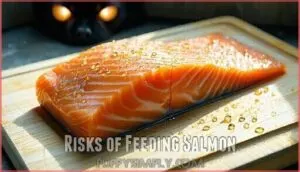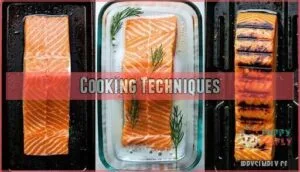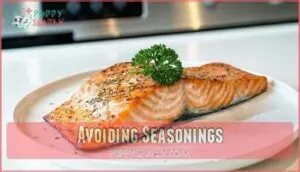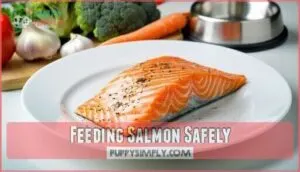This site is supported by our readers. We may earn a commission, at no cost to you, if you purchase through links.
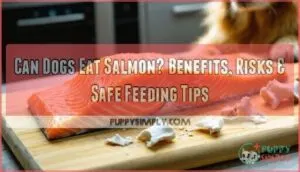
This nutritious fish packs omega-3 fatty acids that’ll give your pup a glossy coat and boost their energy levels.
However, you’ll want to avoid raw salmon entirely – it can harbor dangerous parasites that cause salmon poisoning disease, which can be fatal for dogs.
Always cook salmon thoroughly, remove all bones and skin, and skip any seasonings or salt.
Some dogs might have seafood allergies, so watch for reactions like itching or digestive upset.
When prepared correctly, salmon makes an excellent occasional treat that many premium dog foods already include.
The secret lies in knowing exactly how to prepare it safely.
Table Of Contents
- Key Takeaways
- Benefits of Salmon
- Can Dogs Eat Salmon
- Risks of Feeding Salmon
- Safe Preparation Methods
- Canned Salmon for Dogs
- Alternatives to Salmon
- Feeding Salmon Safely
- Frequently Asked Questions (FAQs)
- Is it safe for dogs to eat salmon?
- Is salmon a good dog food?
- Can dogs eat salmon every day?
- Are dogs allowed to have salmon?
- How much salmon is safe for dogs?
- What fish can dogs not eat?
- Can pregnant dogs eat salmon safely?
- How often can dogs eat salmon?
- What happens if dogs eat salmon bones?
- Can puppies eat salmon at what age?
- Conclusion
Key Takeaways
- You can safely feed your dog cooked salmon – it’s packed with omega-3 fatty acids for a shiny coat and joint health, but always cook it thoroughly to 145°F and remove all bones and skin first.
- Never give your dog raw salmon – it contains deadly parasites that cause salmon poisoning disease, which has a 90% fatality rate if left untreated and can kill your pet within days.
- Keep portions small and occasional – limit salmon to 1-2 tablespoons for small dogs or up to 1/2 can for large dogs, serving it only once or twice weekly as a treat, not a daily meal.
- Watch for allergic reactions when introducing salmon – start with tiny amounts and monitor for itching, vomiting, or digestive upset, stopping immediately if you notice any adverse reactions.
Benefits of Salmon
You might wonder if salmon is healthy for your dog – and the answer is yes, when prepared properly.
Salmon packs impressive nutritional benefits that can support your dog’s overall health and well-being.
Nutritional Value
Salmon delivers top-tier protein source benefits for dogs, packing approximately 18.8 grams of high-quality protein per 85-gram serving.
This nutritional powerhouse supports muscle development while offering exceptional digestibility factors that make it perfect for sensitive stomachs.
The vitamin content includes essential B12, selenium, and vitamin D, while mineral richness provides phosphorus and potassium for peak health.
Additionally, salmon is a good source of omega-3 fatty acids, which can help reduce inflammation and support overall peak health with its essential nutrients.
Omega-3 Fatty Acids
One key nutritional powerhouse making salmon a smart choice for your dog’s diet is its rich omega-3 fatty acids content.
These omega-3 powerhouses transform your dog’s health from the inside out, supporting everything from brain function to joint mobility.
These healthy fats pack a serious punch for your pet’s wellbeing.
- EPA and DHA support brain development and cognitive function in puppies and senior dogs
- Joint health benefits reduce inflammation and improve mobility for active pups
- Heart benefits promote cardiovascular health and circulation throughout your dog’s body
- Inflammation reduction helps manage arthritis symptoms and supports overall immune function
Healthy Coat and Skin
Beyond those powerful omega-3 benefits, you’ll notice your dog’s appearance transforming.
The same fatty acids that support internal health work wonders on your pet’s exterior.
Regular salmon feeding can reduce skin irritations and provide itch relief for dogs struggling with allergy symptoms.
Your pup’s coat will develop a lustrous shine that’s hard to miss.
| Before Salmon | After Salmon |
|---|---|
| Dull, brittle fur | Glossy coat shine |
| Itchy, flaky skin | Smooth, healthy skin |
| Frequent scratching | Comfortable, calm dog |
Can Dogs Eat Salmon
Yes, dogs can eat salmon, but preparation matters substantially. Cooked salmon dogs can safely enjoy provides excellent nutrition when prepared correctly.
However, raw salmon dogs should never consume poses serious health risks. The answer depends on how you serve it.
Wild vs farmed salmon both work, though wild-caught typically contains fewer contaminants. When preparing salmon for dogs, avoid cooking oils high in fat – plain preparation works best.
Salmon portions should match your dog’s size and breed sensitivity varies considerably. Small dogs need just 1-2 tablespoons, while large breeds can handle up to half a can of cooked salmon.
Some breeds show greater salmon allergies susceptibility, so start with tiny amounts. Can dogs eat salmon regularly? It’s best as an occasional treat, not daily meals.
Salmon poisoning dogs can develop from raw fish makes proper cooking non-negotiable. Always cook to 145°F internal temperature to eliminate harmful parasites and bacteria that cause serious illness.
To prevent complications, it’s also vital to reflect on the potential for intestinal blockage from bones.
Risks of Feeding Salmon
While salmon offers excellent nutritional benefits for dogs, you need to understand the potential risks before adding it to your pet’s diet.
Raw or improperly prepared salmon can expose your dog to serious health complications that require immediate veterinary attention, as improperly prepared salmon poses significant threats.
Raw Salmon Risks
Raw salmon poses serious health threats that every dog owner should understand.
Raw salmon carries deadly parasites that can kill your dog within days if left untreated.
The Pacific Northwest’s salmon carries particularly dangerous risks due to regional parasite exposure patterns.
- Salmon poisoning disease from Neorickettsia helminthoeca has a 90% fatality rate in untreated dogs
- Bone hazards create choking risks and internal injuries requiring emergency surgery
- Bacterial threats include Salmonella and Listeria contamination
- Parasite dangers involve flatworms that transmit deadly infections
Without treatment, salmon poisoning is often fatal, so early veterinary intervention is critical.
Parasites and Bacteria
Raw salmon dogs shouldn’t consume contains dangerous parasites like Neorickettsia helminthoeca, which causes salmon poisoning disease.
This parasite lives in flukes found in Pacific salmon and can be fatal if untreated.
Bacterial infections also lurk in uncooked fish. Safe temperatures mean cooking salmon thoroughly—cooked salmon eliminates these risks, making salmon for dogs much safer than raw alternatives.
Allergic Reactions
Some dogs experience allergic reactions to salmon, though fish allergies are less common than chicken or beef sensitivities. Signs include itching, digestive upset, and skin irritation. Gradual introduction helps identify salmon allergies dogs may develop, especially in breeds with food sensitivities.
Watch for these dog allergy symptoms:
- Persistent scratching – Your pup becomes their own worst enemy, clawing at red, inflamed skin
- Digestive chaos – Vomiting and diarrhea turn mealtime into a nightmare
- Swollen face or paws – Your furry friend looks like they went ten rounds with a bee
- Respiratory distress – Wheezing and labored breathing signal serious trouble
- Chronic ear infections – Constant head shaking and foul odors become the new normal
If reaction symptoms appear, stop feeding salmon immediately. Consult your veterinarian about allergy testing and novel proteins as alternatives. An elimination diet trial is key to diagnosing the allergy. Some breeds show higher predisposition to food allergies, making careful monitoring essential during any dietary changes.
Safe Preparation Methods
When you cook salmon for your dog, you’re making it safe while keeping all the good stuff intact.
The key is proper cooking, bone removal, and skipping any seasonings that could harm your furry friend.
Cooking Techniques
Several cooking methods guarantee well-cooked salmon for dogs. Baking at 350°F for 20 minutes or poaching vs. grilling both work well.
Baking temperatures should reach 145°F internally. Steaming and boiling preserve nutrients without added fats.
Safe seasonings? None—skip oil selection entirely. For specialized treats, consider salmon dog baking.
Overcooking concerns are minimal since thorough cooking kills parasites. These cooking methods for dogs prioritize safety over gourmet appeal, ensuring well-cooked salmon is always the result.
Removing Bones and Skin
Every single bone must be removed from salmon for dogs – even boneless fillets can contain tiny bones that pose choking hazards.
Use tweezers or bone removal tools to inspect thoroughly.
Remove salmon skin dogs shouldn’t eat due to high fat content, though small safe skin amounts won’t harm most dogs.
As with chicken bones, splintering poses risks to your dog’s health.
After bone detection methods confirm removal, proceed with cooking your prepared boneless fillets safely.
Avoiding Seasonings
When preparing salmon for your dog, keep seasonings off the menu entirely.
Salt, garlic, onions, and most spices contain toxic ingredients that can harm your furry friend.
Skip fancy flavors and stick to plain preparation – your dog’s taste buds prefer natural flavors anyway.
Homemade broths without salt work well for moisture.
Remember, plain cooked salmon provides all the dog salmon benefits without safety concerns.
Safe foods for dogs don’t need our human seasonings to taste great.
Canned Salmon for Dogs
Canned salmon offers a convenient way to give your dog this nutritious fish without the hassle of cooking fresh fillets.
You’ll want to choose the right type and prepare it properly to keep your furry friend safe and healthy.
Choosing Safe Canned Salmon
When shopping for canned salmon, you’ll want to focus on five key factors to keep your dog healthy and happy:
- Sodium Content: Choose low-sodium or no-salt-added varieties (around 25mg per serving vs. 270mg in regular)
- Oil-Packed Risks: Select water-packed salmon to avoid digestive issues and pancreatitis
- Additive-Free Brands: Stick to ingredients listing only salmon and water
- Bone Removal: Consider deboned options for gulping dogs, though soft canned bones are generally safe
- Rinsing Methods: Always drain and rinse to remove excess sodium and oil residues
Wild-caught varieties offer better omega-3 content than farm-raised options.
For low sodium options, explore specialized retailers.
Serving Sizes and Portion Control
When choosing canned salmon, proper portion control keeps your dog healthy and happy. Dog weight determines serving sizes, with smaller pups needing less than larger breeds.
Daily limits prevent overfeeding, while treat frequency should remain occasional rather than routine meals. Remember that salmon treats count toward your dog’s total daily calories.
| Dog Weight | Serving Size | Daily Limits | Treat Frequency | Calorie Adjustment |
|---|---|---|---|---|
| Small (10-25 lbs) | 1-2 tablespoons | Once weekly | 2-3 times/week max | Reduce main meal by 10% |
| Medium (26-50 lbs) | 1/4 can | Once weekly | 2-3 times/week max | Reduce main meal by 15% |
| Large (51-75 lbs) | 1/2 can | Once weekly | 2-3 times/week max | Reduce main meal by 20% |
| Extra Large (76+ lbs) | 3/4 can | Once weekly | 2-3 times/week max | Reduce main meal by 25% |
| Puppies (all sizes) | Half adult portion | Twice weekly | 1-2 times/week max | Replace 5% of puppy food |
Weight management requires adjusting regular meals when adding salmon to prevent unwanted pounds. Puppy portions should be smaller since their digestive systems are still developing. Consider exploring options for a dog salmon portion to confirm appropriate serving sizes. This will help in maintaining a healthy and happy dog, with daily limits and calorie adjustment in check.
Rinsing Excess Salt
Before feeding your dog canned salmon, always rinse it thoroughly under cold water to remove excess salt and oil.
This simple step makes canned salmon safer for your furry friend’s sodium-sensitive system.
Here’s why rinsing benefits your dog’s health:
- Prevents dehydration – Excess sodium can leave your pup constantly thirsty and strain their kidneys
- Reduces blood pressure risks – High salt intake can spike your dog’s blood pressure dangerously
- Improves digestibility – Clean, rinsed salmon is gentler on sensitive stomachs and easier to process
Choose water-packed options over oil or brine varieties for the safest consumption.
Even with rinsing, moderation remains key when adding salmon to your dog’s diet.
Alternatives to Salmon
If salmon doesn’t work for your dog, you’ve got plenty of other nutritious options to explore.
Other fish like sardines, mackerel, and whitefish offer similar omega-3 benefits, while chicken, turkey, and lean beef provide excellent protein alternatives for dogs with fish sensitivities.
Other Fish Options
Beyond salmon, you’ll find plenty of safe fish options for your furry friend.
Whitefish benefits include lean protein and easy digestion.
Sardine nutrition offers calcium and omega-3s in small packages.
Herring options provide vitamin D for strong bones.
Cod advantages include low mercury levels and high protein.
| Fish Type | Protein Content | Key Benefits |
|---|---|---|
| Whitefish | 38g per 154g | Low fat, ideal for weight management |
| Sardines | High | Calcium, selenium, coenzyme Q10 |
| Herring | 33g per 143g | Vitamin D, supports teeth and bones |
| Cod | High | Low toxins, lean protein source |
These seafood for dogs alternatives work well when you’re looking for fish allergies solutions or simply want variety in your pup’s diet.
Non-Fish Protein Sources
If salmon doesn’t suit your dog’s needs, plenty of alternative protein sources exist.
Chicken alternatives like turkey and duck work well for sensitive pups.
Beef options include lamb and venison for variety.
Plant proteins aren’t complete for dogs, but egg benefits include easy digestion.
Dairy sources should be limited due to lactose intolerance.
Consulting a Veterinarian
When you’re making dietary changes for your dog, it’s smart to loop in your veterinarian first.
They know your pup’s health history and can spot potential issues before they become problems.
Your vet can provide personalized advice based on:
- Breed predispositions – certain breeds have specific nutritional needs
- Underlying conditions – allergies or health issues requiring special consideration
- Specific concerns – age, weight, or medication interactions
Professional veterinary advice guarantees your dog nutrition plan works safely with their unique needs.
For quick questions, consider using online vet services for convenience.
Feeding Salmon Safely
Once you’ve prepared salmon properly, you’ll want to watch your dog carefully for any signs of allergic reactions during their first few servings.
Remember that salmon should complement, not replace, your dog’s regular balanced diet to guarantee they get all the nutrients they need, and always ensure it supports their overall health.
Monitoring for Allergic Reactions
Watch for reaction symptoms like itching, vomiting, or diarrhea when introducing salmon to your dog’s diet.
Start with gradual introduction using small portions to identify any dog allergies or dietary sensitivity. Some breeds show predisposition to fish allergies, making careful monitoring important.
If you notice unusual dog dietary reaction signs, stop feeding salmon immediately and seek vet consultation for proper allergy testing and guidance to address potential fish allergies.
Maintaining a Balanced Diet
Remember that salmon should complement, not replace, your dog’s regular meals.
This protein source offers excellent nutritional value, but your pup needs variety to meet all their dietary guidelines.
- Follow the 10% rule: Treats like salmon shouldn’t exceed 10% of your dog’s daily calorie intake
- Adjust regular portions: Reduce your dog’s kibble when adding salmon to maintain proper calorie control
- Rotate protein sources: Mix salmon with other proteins to guarantee complete nutritional needs are met
Frequently Asked Questions (FAQs)
Is it safe for dogs to eat salmon?
Like walking a tightrope, feeding salmon to dogs requires balance and caution.
Yes, it’s safe when properly cooked, deboned, and unseasoned.
Never serve raw salmon—it contains deadly parasites.
Cook thoroughly to 145°F and serve occasionally.
Is salmon a good dog food?
Yes, salmon’s an excellent dog food when properly prepared.
You’ll get high-quality protein, omega-3 fatty acids for shiny coats, and joint support.
Always cook thoroughly and remove bones to avoid salmon poisoning disease.
Can dogs eat salmon every day?
Dogs shouldn’t eat salmon every day.
While cooked salmon offers excellent nutrition, daily consumption can cause digestive upset, pancreatitis, or mercury buildup.
Limit salmon to once or twice weekly as an occasional treat.
Are dogs allowed to have salmon?
Picture your furry friend’s tail wagging with anticipation as they smell that delicious salmon cooking.
You can safely feed your dog salmon, but it must be fully cooked and boneless to avoid dangerous parasites and choking hazards.
How much salmon is safe for dogs?
Feed your dog salmon as an occasional treat, not daily. Limit portions to 1-2 tablespoons for small dogs, 1/4 can for medium dogs, and 1/2 can for large dogs per serving.
What fish can dogs not eat?
Avoid feeding your dog tuna, swordfish, king mackerel, and shark, as these longer-lived fish contain dangerous mercury levels.
Raw salmon, trout, shad, or sturgeon can also carry parasites causing salmon poisoning disease.
Can pregnant dogs eat salmon safely?
Better safe than sorry" rings true for expectant mothers.
Yes, pregnant dogs can eat properly cooked, boneless salmon as an occasional treat.
The omega-3 fatty acids support both mom’s health and puppy development, but you’ll want to avoid raw salmon completely due to parasite risks.
How often can dogs eat salmon?
You can feed your dog salmon once or twice a week as an occasional treat. Limit portions to about 1-2 ounces per 50 pounds of body weight to avoid digestive upset.
What happens if dogs eat salmon bones?
Salmon bones pose serious choking hazards and can lodge in your dog’s throat, stomach, or intestines. They’re small, brittle, and can cause internal damage requiring emergency veterinary care.
Can puppies eat salmon at what age?
About 70% of puppies can safely eat cooked salmon starting at 8-12 weeks old.
You’ll want to introduce it gradually after they’re weaned and eating solid food.
Always serve thoroughly cooked , boneless salmon in tiny portions.
Conclusion
Remember that old saying about good things coming to those who wait? In the case of feeding your dog salmon, patience in proper preparation pays off tremendously.
Can dogs eat salmon? Absolutely, but only when you’ve taken the time to cook it thoroughly and remove all bones and skin.
Your furry friend will thank you for the omega-3 boost, and you’ll rest easy knowing you’ve avoided the serious risks that come with raw fish.
Start with small portions, watch for any allergic reactions, and always consult your veterinarian before making significant dietary changes.
- https://canidae.com/blog/the-many-benefits-of-dog-food-with-salmon
- https://zignature.com/6-benefits-of-feeding-your-dog-salmon/
- https://kabo.co/blog/8-benefits-of-feeding-your-dog-salmon
- https://www.earthbornholisticpetfood.com/blog/pet-nutrition/can-dogs-eat-salmon/
- https://www.petco.com/content/content-hub/home/articlePages/food-nutrition/can-dogs-eat-salmon.html


